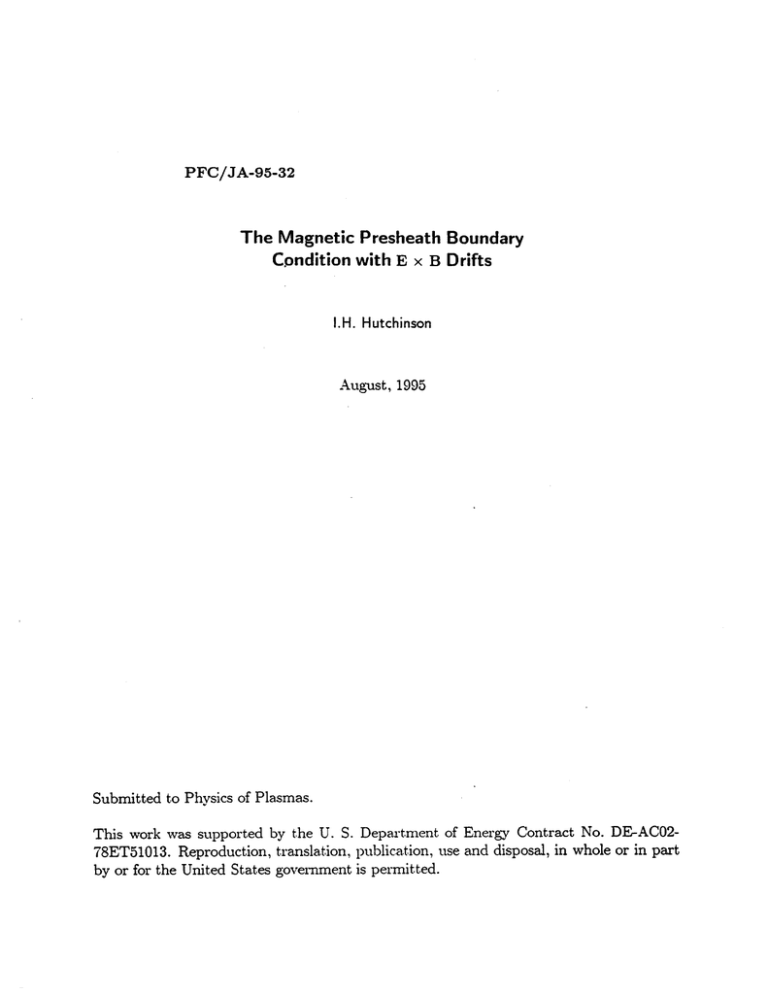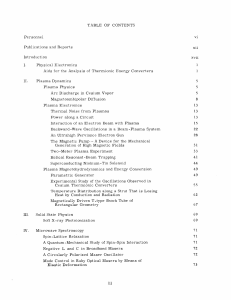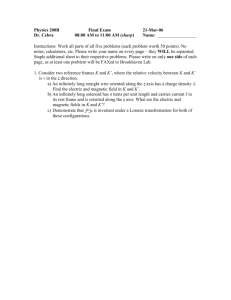The Magnetic Presheath Boundary with E Condition Drifts
advertisement

PFC/JA-95-32 The Magnetic Presheath Boundary Condition with E x B Drifts I.H. Hutchinson August, 1995 Submitted to Physics of Plasmas. This work was supported by the U. S. Department of Energy Contract No. DE-AC0278ET51013. Reproduction, translation, publication, use and disposal, in whole or in part by or for the United States government is permitted. The Magnetic Presheath Boundary Condition with ExB Drifts I.H.Hutchinson Plasma Fusion Center Massachusetts Institute of Technology Cambridge, Massachusetts, USA Abstract It is demonstrated rigorously that the effects on a one-dimensional, collisionless, magnetic presheath with oblique magnetic field B of a uniform tangential electric field, causing a drift VD = E x B/B 2 , are equivalent to a transformation to a frame moving tangential to the surface. Therefore, in particular, the Chodura solution with parallel velocity, vj = c, (the sound speed) is transformed into a solution with vjj field angle to the surface. PACS: 52.55 Fa, 52.40 Hf 1 = c, + VD / tan a where a is the Introduction The magnetic presheath is a region of acceleration close to the boundary of a plasma in contact with a solid surface, in which a magnetic field B exists at an oblique angle a to the surface. In obtaining detailed solutions of the plasma equations, the region is generally considered to be divided into a Debye sheath region, where quasi-neutrality is violated, and a magnetic presheath region with thickness of order the ion gyro-radius, where the ions are accelerated across the field to enter the sheath at the sound speed. For present purposes, we will refer to the combined sheath and magnetic presheath region loosely as the magnetic presheath. Standard solutions of the magnetic presheath problem have been calculated. When collisions are negligible, the solution of Chodural applies. As Riemann has also shown2 this solution requires the plasma ions to flow into the magnetic presheath with parallel velocity greater than or equal to the sound speed. This inflow condition is then taken as the boundary condition to be applied to solutions of the external plasma region. The boundary condition is extremely important in understanding the behavior of the divertor and scrape-off-layers of tokamaks. However, it is known that particle drifts caused by electric fields are substantial in these situations. Therefore the extent to which these perpendicular electric fields may change the boundary conditions is of vital importance. Stangeby and Chankin 3 have discussed the effects of E xB drifts on the magnetic presheath boundary condition. On the basis of "intuition" they anticipate that the boundary condition will be modified such that the incoming parallel flow speed will be vg = c. + vD/ tan a. They also derive a generalized form of this condition, from an approximate analysis of the ion fluid equations. However, the lack of rigor in Stangeby and Chankin's analysis and the complexity of their attempt to account for various extra effects (which 2 may well be important in practice) tends to obscure the result, and seems to leave doubt as to its applicability. Therefore a rigorous analysis is provided here of a more specific geometric case, which nevertheless contains the essential effect. The present analysis is general, applicable to any collisionless plasma, and not dependent, for example, on fluid or other approximations. The Stangeby and Chankin result is broadly confirmed but several subtle questions remain. Analysis We consider a planar, one dimensional magnetic presheath, in which z and y are ignorable coordinates. The solid surface consists of an zy plane that may be taken as z = 0 and the magnetic field is in the zz plane. We are interested in the effect of a uniform electric field in the y-direction, Es. In elementary plasma analysis, it gives rise to a drift velocity E x B/B 2 = E,,Bx - EBj. Naturally there is, in addition, a self consistent electrostatic field -VO in the z-direction arising from the presheath structure. Now we note that the particles of a collisionless plasma obey the equation of motion d T(mY)=q(E+vxB) where m and q are the particle mass and charge respectively. For non-relativistic velocities, Vt, the Galilean transformation of the parameters of this equation to an inertial frame travelling with velocity vt is V' = V - Vt (2) B'= B E' = E+vxB and equation (1) is still satisfied by the primed quantities. The Maxwell equations, which complete those obeyed by the plasma, are also invariant under this transformation (for 3 non-relativistic vs). If we assume, as is usually done, that the boundary condition imposed by the solid is simply that all particles impinging on it are absorbed, then the boundary condition is also unchanged by this transformation provided that vt lies in the plane of the ignorable coordinates xy. Therefore, from any solution of equation (1), and the related plasma equations, we can generate solutions to related problems in which the electric field has an extra component vt xB, by transforming to the moving frame. In particular, if there is in the lab frame an extra field E,, the required transformation velocity is V = iE- = iE B, Bsina (3) ' which will render E, = 0 in the transformed frame. The primed quantities may therefore be taken to be a solution to the standard collisionless magnetic presheath problem. The archetypical solution of this drift-free problem' has as its asymptotic solution for the ion velocity far from the solid surface (at large negative z): sina) v=c,(i cosa+ (4) , that is, parallel inflow at the sound speed, c, (although inflow at any supersonic speed gives a consistent magnetic presheath solution). The corresponding solution when the extra field E. is present is therefore V = c, icosa .) + + i sina , (5) which may be written V=$ (C. + tan a + (yb)VD ,(6) where VD has the sign of E,. Thus we obtain the standard perpendicular drift velocity plus velocity parallel to B altered by vD/ tan a. 4 Discussion That expressions (5) or (6) are a solution to the equations is clear. Whether it is the required solution is more subtle, depending as it does on the boundary condition to be applied far from the surface. The usual condition applied is that the magnetic presheath solution should match smoothly to the outer plasma solution, which is presumed to have scale lengths much longer than the magnetic presheath. For the drift-free case, the magnetic presheath solution requires (super)sonic parallel inflow velocity, and consideration of the dynamics of acceleration in the plasma region usually dictates a (sub)sonic solution there; hence sonic parallel inflow at the join. We shall call this the sonic solution. The case with drift is less clear. The solution in the external plasma region cannot in general be collisionless, because that would prevent acceleration from occuring4 . The most typical presumption is that collisions in the form of ionization are present in the external region; although sources such as momentum drag are also effective in providing a well-posed problem 2 . In either case, the equations of the external plasma are not invariant under the Galilean transformation discussed, and the matching must therefore be considered in the lab frame. If -2c. 5 VD/ tan a < 0, so that the transformed sonic solution has subsonic parallel velocity in the lab frame, it would appear that the external solution can be matched. There is, in fact, a range of supersonic magnetic presheath solutions to which they can be matched and how to chose which solution is appropriate is not obvious. However, if VD/ tan a > 0 or < -2c, then the transformed sonic solution requires supersonic flow in the external solution at the join. This is not necessarily possible. For VD/ tan a < -2c, this problem may be avoided by discarding the sonic magnetic presheath solution and instead adopting a supersonic solution which transforms to vg ;. -c, in the lab frame. The case 5 of VD/ tana > 0 is more problematic since the requirement of supersonic lab-frame inflow appears unavoidable. In conclusion, solutions of the magnetic presheath equations in a plasma with unform electric field, giving an E x B drift, can be obtained by a simple Galilean transformation of solutions of the drift-free problem. The resulting solution in the lab frame adds a parallel velocity VD/ tan a as well as the cross-field drift. However, subtle questions concerning the matching of this solution to the external plasma remain, and can only be resolved by a more detailed description. Acknowledgements It is a pleasure to acknowledge stimulating discussions with P.C. Stangeby. This work was supported by US Department of Energy contract No DE-AC02-78ET5103. References 1 R. Chodura, Phys. Fluids 25, 1628 (1982) 2 K.-U. Riemann, Phys. Plasmas 1, 552 (1994) 3P.C. Stangeby and A.V. Chankin, Phys. Plasmas 2, 707 (1995) 4 I.H. Hutchinson, Principles of Plasma Diagnostics (Cambridge University Press, New York, 1987) p6 7 . 6



